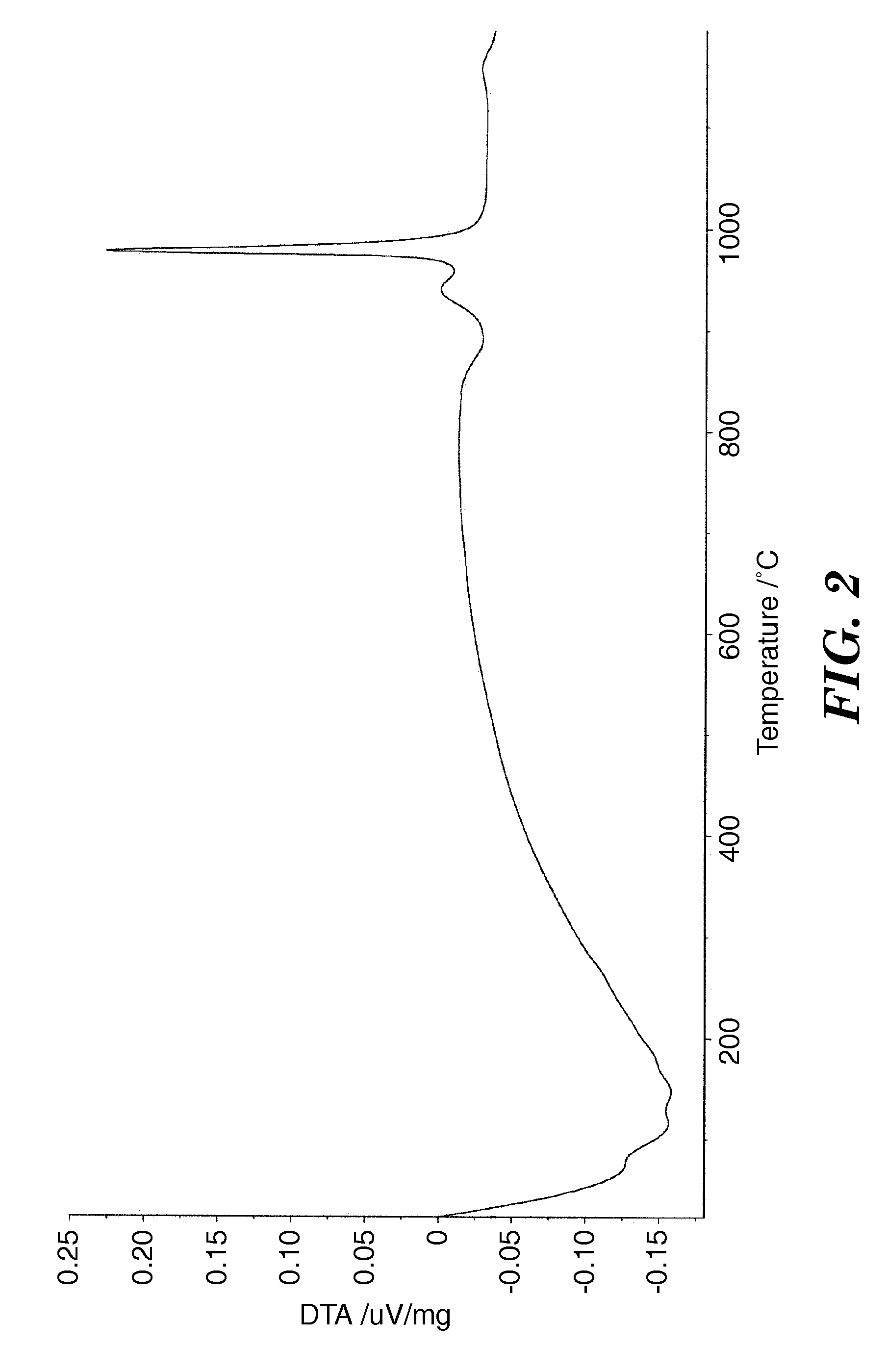Method of making glass-ceramic and articles made therefrom
a technology of glass-ceramic and glass-ceramic plates, applied in the field of making articles, can solve the problems of not being able to form bulky or complex shapes
- Summary
- Abstract
- Description
- Claims
- Application Information
AI Technical Summary
Benefits of technology
Problems solved by technology
Method used
Image
Examples
example 1
[0129]A polyethylene bottle was charged with 27.5 grams of alumina particles (obtained under the trade designation “APA-0.5” from Condea Vista, Tucson, Ariz.), 22.5 grams of calcium oxide particles (obtained from Alfa Aesar, Ward Hill, Mass.) and 90 grams of isopropyl alcohol. About 200 grams of zirconia milling media (obtained from Tosoh Ceramics, Division of Bound Brook, N.J., under the trade designation “YTZ”) were added to the bottle, and the mixture was milled at 120 revolutions per minute (rpm) for 24 hours. After the milling, the milling media were removed and the slurry was poured onto a glass (“PYREX”) pan where it was dried using a heat-gun. The dried mixture was ground with a mortar and pestle and screened through a 70-mesh screen (212-micrometer opening size).
[0130]After grinding and screening, some of the particles were fed into a hydrogen / oxygen torch flame. The torch used to melt the particles, thereby generating melted glass beads, was a Bethlehem bench burner PM2D m...
examples 2-9
[0131]Examples 2-9 glass beads were prepared as described in Example 1, except the raw materials and the amounts of raw materials used are listed in Table 1, below, and the milling of the raw materials was carried out in 90 (milliliters) ml of isopropyl alcohol with 200 grams of the zirconia media (obtained from Tosoh Ceramics, Division of Bound Brook, NJ, under the trade designation “YTZ”) at 120 rpm for 24 hours. The sources of the raw materials used are listed in Table 2, below.
TABLE 1ExampleWeight percent of componentsBatch amounts, g2CaO: 36CaO: 18Al2O3: 44Al2O3: 22ZrO2: 20ZrO2: 103La2O3: 45La2O3: 22.5TiO2: 55TiO2: 27.54La2O3: 36La2O3: 18TiO2: 44TiO2: 22ZrO2: 20ZrO2: 105BaO: 47.5BaO: 23.75TiO2: 52.5TiO2: 26.256La2O3: 48La2O3: 24Al2O3: 52Al2O3: 267La2O3: 40.9La2O3: 20.45Al2O3: 40.98Al2O3: 20.49ZrO2: 18.12ZrO2: 9.068La2O3: 43La2O3: 21.5Al2O3: 32Al2O3: 16ZrO2: 12ZrO2: 6SiO2: 13SiO2: 6.59SrO: 22.95SrO: 11.47Al2O3: 62.05Al2O3: 31.25ZrO2: 15ZrO2: 7.5
TABLE 2Raw MaterialSourceAlumina p...
PUM
| Property | Measurement | Unit |
|---|---|---|
| Tg | aaaaa | aaaaa |
| size | aaaaa | aaaaa |
| Tg | aaaaa | aaaaa |
Abstract
Description
Claims
Application Information
 Login to View More
Login to View More - R&D
- Intellectual Property
- Life Sciences
- Materials
- Tech Scout
- Unparalleled Data Quality
- Higher Quality Content
- 60% Fewer Hallucinations
Browse by: Latest US Patents, China's latest patents, Technical Efficacy Thesaurus, Application Domain, Technology Topic, Popular Technical Reports.
© 2025 PatSnap. All rights reserved.Legal|Privacy policy|Modern Slavery Act Transparency Statement|Sitemap|About US| Contact US: help@patsnap.com



